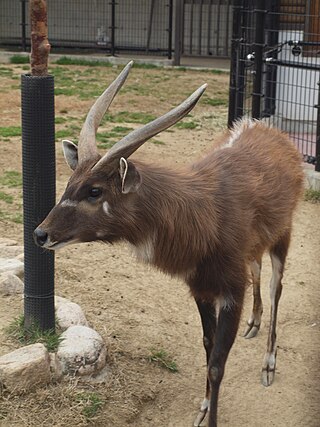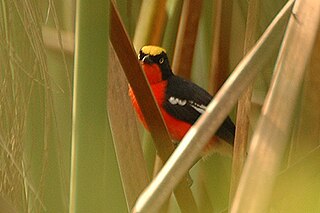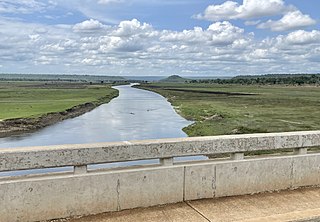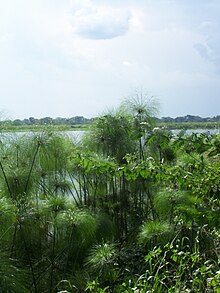
Papyrus is a material similar to thick paper that was used in ancient times as a writing surface. It was made from the pith of the papyrus plant, Cyperus papyrus, a wetland sedge. Papyrus can also refer to a document written on sheets of such material, joined side by side and rolled up into a scroll, an early form of a book.

The Cyperaceae are a family of graminoid (grass-like), monocotyledonous flowering plants known as sedges. The family is large: botanists have described some 5,500 known species in about 90 genera, the largest being the "true sedges" with over 2,000 species.

The Sudd is a vast swamp in South Sudan, formed by the White Nile's Baḥr al-Jabal section. The Arabic word sudd is derived from sadd, meaning "barrier" or "obstruction". The term "the sudd" has come to refer to any large solid floating vegetation island or mat. The area which the swamp covers is one of the world's largest wetlands and the largest freshwater wetland in the Nile Basin.

Lake Naivasha is a freshwater lake in Kenya, outside the town of Naivasha in Nakuru County, which lies north west of Nairobi. It is situated in the Great Rift Valley. The name derives from the local Maasai name ɛnaɨpɔ́sha , meaning "that which heaves," a common Maasai word for bodies of water large enough to have wave action when it is windy or stormy. Naivasha arose from a British attempt to pronounce the Maasai name. Literally, Lake Naivasha means "Lake Lake."

The sitatunga or marshbuck is a swamp-dwelling medium-sized antelope found throughout central Africa, centering on the Democratic Republic of the Congo, the Republic of the Congo, Cameroon, parts of Southern Sudan, Equatorial Guinea, Burundi, Ghana, Botswana, Rwanda, Zambia, Gabon, the Central African Republic, Tanzania, Uganda and Kenya. The sitatunga is mostly confined to swampy and marshy habitats. Here they occur in tall and dense vegetation as well as seasonal swamps, marshy clearings in forests, riparian thickets and mangrove swamps.

Cyperus is a large genus of about 700 species of sedges, distributed throughout all continents in both tropical and temperate regions.

The papyrus gonolek is a species of bird in the family Malaconotidae. It is found in Burundi, Democratic Republic of the Congo, Kenya, Rwanda, Tanzania, and Uganda. It has specialised habitat requirements, being restricted to papyrus swamps. Not yet a threatened species, it has become rare due to habitat loss and pollution.

The Malagarasi River is a river in western Tanzania, flowing through Kigoma Region, although one of its tributaries comes from southeastern Burundi. The river also forms the western border of Tabora Region, the southern border of Kagera Region and the southwestern border of Geita Region. It is the second-longest river in Tanzania behind the Rufiji—Great Ruaha, and has the largest watershed of any river flowing into Lake Tanganyika. The Malagarasi-Muyovozi Wetlands are a designated a Ramsar site. Local tribes have nicknamed the Malagarasi as "the river of bad spirits".

The Nyabarongo is a major river in Rwanda, part of the upper headwaters of the Nile. With a total length of 351 km (218 mi), it is the longest river entirely in Rwanda. It is extended 421 km (262 mi) in Lake Rweru including a 69 km (43 mi) upper course of Kagera River before joining into Ruvuvu River to form the Kagera River. The river begins its course at the confluence of the rivers Mbirurume and Mwogo in the South West of the country. These two rivers themselves begin in Nyungwe Forest, and are considered by some to be the most distant source of the Nile. From its start, Nyabarongo flows northward for 85 km, and forms the border between the Western and Southern Provinces. At the confluence with the river Mukungwa, the river changes course and flows eastward for 12 km, then to a more South Eastern course for the last 200 km. For the longest stretch of this course, the river serves as the boundary between the Northern and Southern Provinces, then between the City of Kigali and the Southern Province, and lastly between the City of Kigali and the Eastern Province.
The Gilgil River drains part of the floor of the Great Rift Valley, Kenya and the plateau to the east of the valley, flowing from the north into Lake Naivasha. The river runs to the east of the town of Gilgil, which is on the height of land between the Lake Naivasha and Lake Elmenteita basins.

Cyperus articulatus is an aromatic species of sedge known by the common names jointed flatsedge and priprioca. It has also been known as Guinea rush or adrue. It grows as a perennial herb. It grows in water or near it in rivers, streams, lakes, and swamps with a hyperhydrate or possibly tenagophyte growth pattern. It is widespread across tropical and subtropical regions in Africa, southern Asia, northern Australia, the southeastern United States, the West Indies, and Latin America. While it is closely related to highly invasive sedges such as purple nut sedge, priprioca is less prolific and competitive than its relative.
Cyperus alopecuroides, commonly known as the foxtail flatsedge, is a sedge of the family Cyperaceae that is native to parts of Africa, Asia and Australia.
Cyperus digitatus, also known as finger flatsedge in the United States, and chang xiao sui suo cao in China, is a sedge of the family Cyperaceae that is native to tropical and subtropical areas of Africa, Asia, the Americas and Australia.
Cyperus hamulosus is a sedge of the family Cyperaceae. It is native from Bulgaria east to Mongolia, and from Morocco in north Africa down to Namibia in the south. It has also been introduced to western parts of Australia.
Cyperus pulchellus is a sedge of the family Cyperaceae that is native to northern Australia, tropical Africa, northwest Madagascar and Southeast Asia.
Cyperus dubius, the soft sedge, is one of around 700 species of Cyperus in the sedge family, Cyperaceae. It is found throughout in tropical Africa, South India, and Indo-China to Malesia. It grows in seasonally flooded areas and in pockets of soil among rocks. It is not confined to wetlands and is sometimes found as a weed in fields, near the sea on sandy beaches and also seen in open shady places.

The Nile Delta flooded savanna, ecoregion covers both the Nile Delta proper, where the Nile River enters the Mediterranean Sea, as well as the river floodplains of the Nile 1,100 kilometres (680 mi) up-river to the Aswan Dam. Since the Aswan Dam was completed in the 1970s, the Nile on this stretch has not been subject to annual flooding, leading the loss of much of the papyrus sedge swamps and other marshes along the river.
Cyperus afroalpinus is a species of sedge that is native to Africa and was described by the botanist Kåre Arnstein Lye in 1983.
Cyperus holstii is a species of sedge that is native to central Africa, including the Democratic Republic of the Congo, Tanzania, and Kenya.
















